10 Best Interprefy Alternatives

If you’re exploring Interprefy alternatives, you’ll find that the market offers a range of platforms designed to meet different multilingual communication needs. From real-time translation and AI-powered captions to large-scale event localization, the right solution depends on your specific goals.
The best alternative isn’t just about matching Interprefy’s core features; it’s about finding a platform that offers the right balance of language coverage, reliability, scalability, and ease of use. Whether you’re hosting a global conference, running a webinar, or teaching an online class, choosing wisely can save you time, reduce costs, and deliver a smoother experience for your audience.
What features should I look for in an Interprefy alternative?
When choosing an Interprefy alternative, focus on the features that best match your event’s needs. Some key aspects to consider include:
- Language support: Make sure the platform covers all the languages your audience requires.
- Type of interpretation: Decide whether you need human interpreters, AI-powered translation, or a mix of both.
- Ease of access: Look for browser-based or app-free solutions so attendees don’t struggle with setup.
- Audio & video quality: High-quality, low-latency streaming is essential for participants to follow smoothly.
- Scalability: Check if the platform can handle small meetings as well as large-scale conferences or webinars.
- Integration options: Some tools connect seamlessly with Zoom, Teams, or event platforms, saving you time.
- Extra features: Consider things like real-time captions, voice cloning, polling, or analytics for added value.
The best Interprefy alternative is the one that balances reliability, usability, and affordability while fitting the size and purpose of your events.
.webp)
10 Best Interprefy Alternatives for Real-Time Translation
Below, we’ve reviewed the 10 best Interprefy alternatives, ranked by features, ease of use, pricing, and customer satisfaction.
| Interprefy Alternatives | Number of Supported Languages | Pricing |
| Maestra | 125+ | Free 10 minutes of live transcription; real-time voice translation starts at $79/month |
| KUDO | 60+ | Custom quotes; “Pay-As-You-Go” + enterprise/annual plans |
| Interactio | 100+ | Custom quotes; one-time or license pricing available — contact sales for event quotes. |
| Wordly | 60+ | Pricing based on package size (hours and attendees); custom quotes available |
| VoiceBoxer | Multi-language via human interpreters (contact sales) | Pricing / plans are custom — contact VoiceBoxer / Boostlingo for quotes. |
| Lingmo Translation | 80+ | Small consumer plans (app subscriptions) and business plans; per-use / subscription options — see vendor pricing |
| Clevercast | 8 | Plans from approx. €390–€690/mo for multilingual/AI packages; custom/managed plans available. |
| ZipDX | Language coverage via human interpreters (phone/remote RSI) | Pricing mixes interpreter hourly rates + connection fees; examples and cost guidance on site (contact sales for exact quotes). |
| Wordfast | Platform-agnostic — supports any language pair your TMs contain | One-time licenses / perpetual & discounted pricing: Wordfast Classic/Pro (example: Classic ~$480 buy). |
| SpeakUs | Multi-language (remote RSI); contact sales for specifics | Commercial / enterprise pricing; demo / contact for quote. speakus.io+1 |
1.Maestra AI
If you’re looking for the best live translation tool for meetings, webinars, or classrooms, Maestra is a powerful option. This AI-powered live voice translator works directly in your browser—no downloads or installations needed. It instantly translates spoken audio and provides real-time captioning in more than 125 languages, so participants can both listen to translated voices and read captions in the original and translated language at the same time.
What makes Maestra stand out is its ability to deliver highly accurate translations with natural-sounding voices while keeping latency low. The result is smooth, uninterrupted communication, making it ideal for environments where timing and clarity are essential.
- Best for: Businesses, educators, and event organizers who need instant translation for live events, webinars, or online classes without complex setup.
- Standout feature: Real-time
voice cloning that preserves the speaker’s unique tone and style, ensuring
authenticity in every translation.
If you need a reliable, easy-to-use solution to break language barriers, Maestra is one of the top tools to consider.
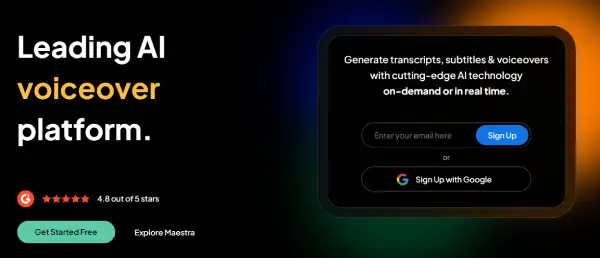
Key Features
- Automatic transcription in 125+ languages
- AI-powered dubbing and voiceovers with natural-sounding voices
- Subtitling and captioning for videos
- Secure cloud storage for projects
- Easy collaboration and editing tools
Pros
- All-in-one tool (transcription, translation, dubbing, captions)
- Affordable compared to traditional interpretation platforms
- Intuitive interface suitable for non-technical users
- Wide variety of AI voices for dubbing
- Very strong live interpretation tool
Cons
- Accuracy may vary slightly depending on audio quality
- You need a subscription to use unique features such as live translation
2.KUDO
KUDO is a popular platform for multilingual online meetings and live events. It specializes in providing live human interpreters combined with digital meeting support. KUDO supports a vast range of languages, including rare and regional ones, making it suitable for global organizations that need accuracy and inclusivity. It also offers AI-powered speech translation for faster turnaround when human interpretation isn’t required.
The platform integrates seamlessly with major conferencing tools like Zoom and Webex, so teams don’t have to change their workflows. With scalable solutions and enterprise-level security, KUDO is often chosen by international businesses, NGOs, and government institutions that prioritize both reliability and compliance.
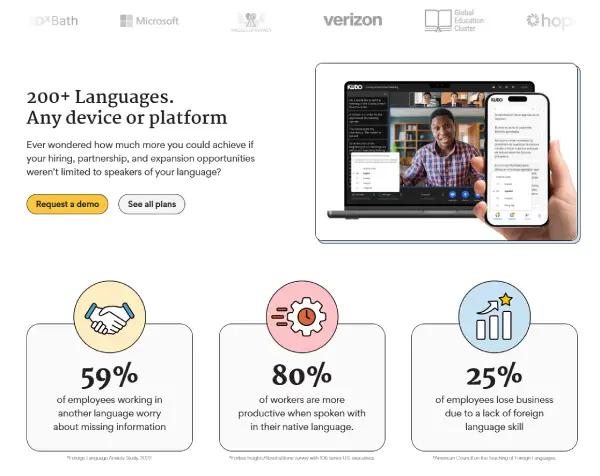
Pros
- Excellent for live, multilingual virtual conferences
- Integration with major platforms like Zoom and Webex
- Access to professional interpreters on demand
Cons
- Pricing can be high compared to AI-driven tools
- Heavier setup for small teams or casual use
3.Interactio
Interactio is widely used by international organizations, including the European Parliament, thanks to its reliability for high-stakes events.
The platform supports both onsite and remote interpreters, ensuring flexibility for hybrid setups. It also offers features like audience polling, analytics, and seamless integration with popular streaming platforms, making it a comprehensive solution beyond just interpretation.
With a proven track record in managing events with thousands of attendees, Interactio stands out as a trusted partner for global conferences and multilingual gatherings.
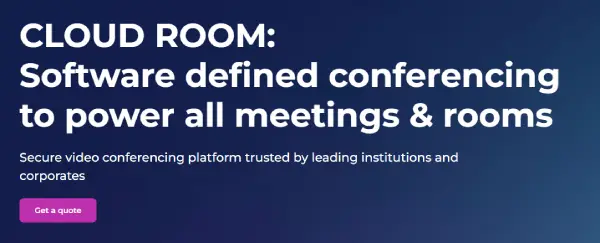
Pros
- Seamless mobile app for attendees
- Good scalability for global events
- Trusted by NGOs and global organizations
Cons
- Not ideal for small businesses or content creators
- Requires human interpreters (higher costs)
4.Wordly
Wordly is an AI-powered interpretation platform designed for scalability and ease of use. Unlike traditional human-based interpreting services, it automates translations in real time, making it a cost-effective choice for organizations hosting frequent multilingual meetings.
Supporting more than 60 languages, Wordly works seamlessly in webinars, conferences, and training sessions without requiring additional equipment or interpreter scheduling. Its pricing is flexible, based on hours and attendees, with custom quotes available for larger events. For companies seeking a reliable, always-available solution, Wordly offers speed, convenience, and consistent quality.
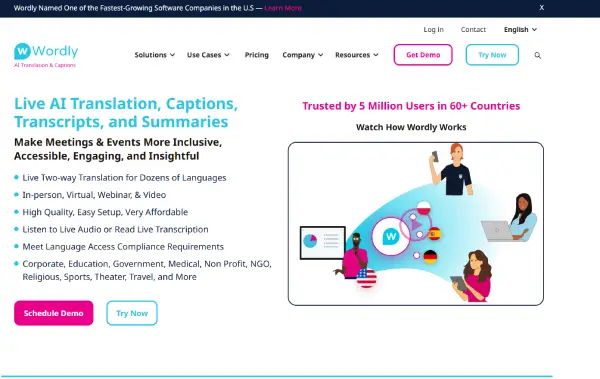
Pros
- AI-powered real-time translations
- Cost-effective for recurring meetings
- Easy integration with video conferencing platforms
Cons
- AI accuracy varies depending on context
- Voices can sound robotic compared to human interpreters
5.VoiceBoxer
VoiceBoxer is a multilingual communication platform built for interactive presentations, training sessions, and webinars. It allows interpreters to work remotely while attendees choose their preferred language for both audio and captions.
The platform includes features like Q&A, polls, and audience engagement tools, making it more dynamic than standard interpretation services. With flexible integration into existing virtual event setups, VoiceBoxer is a strong choice for companies that prioritize both multilingual access and interactive participation.

Pros
- Good audience engagement tools (polls, Q&A)
- Easy for presenters and interpreters to collaborate
- Browser-based, no downloads required
Cons
- More focused on live events than post-production tools
- Less AI automation compared to Maestra
6. Lingmo Translation
Lingmo is an AI-driven translation and interpretation company that offers both live translation tools and wearable technology.
Known for its innovative solutions, Lingmo provides instant voice and text translations across multiple languages, making it useful not only for conferences but also for travel, customer service, and enterprise communication. By combining AI with customizable business applications, Lingmo bridges communication gaps quickly and efficiently. Its versatility makes it a valuable choice for organizations seeking more than just event interpretation.
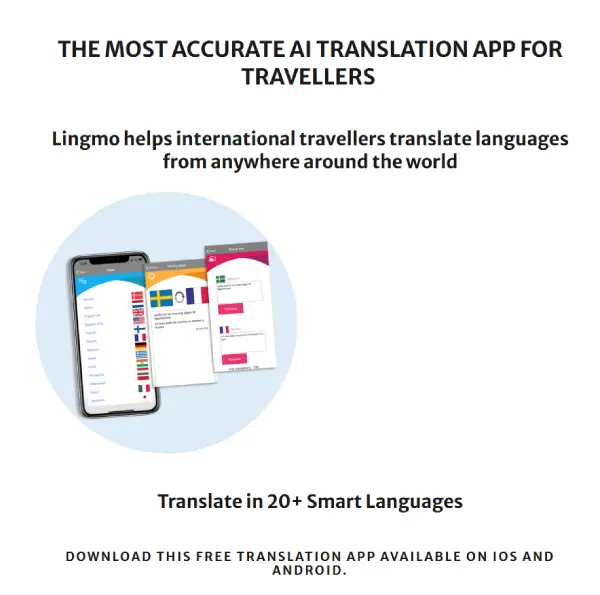
Pros
- AI-driven, reducing reliance on human interpreters
- Can be integrated into business workflows
- Multilingual transcription support
Cons
- Not as feature-rich for video content
- Limited customization compared to competitors
7. Clevercast
Clevercast is a remote simultaneous interpretation (RSI) platform tailored for live streaming and hybrid events.
It allows interpreters to work from anywhere and broadcasts real-time translations to participants via a simple web player.
Clevercast supports multiple languages simultaneously and is optimized for large-scale online events, including webinars and conferences.
With advanced streaming features, robust scalability, and user-friendly access for attendees, it’s a practical solution for professional event organizers and corporations hosting international meetings.
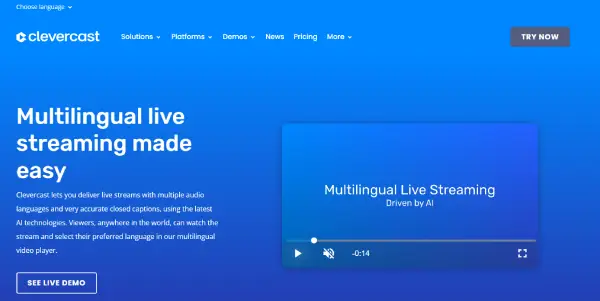
Pros
- Perfect for live-streaming global events
- Good captioning integration
- Supports professional interpreter workflows
Cons
- Best for broadcasters, less for casual creators
- Pricing on the higher side
8. ZipDX
ZipDX is a conferencing platform specializing in multilingual communication. It allows participants to join meetings in their chosen language while interpreters work seamlessly in the background.
Known for its flexibility and audio quality, ZipDX is particularly useful for teleconferences and audio-driven meetings.
Unlike many newer platforms, ZipDX has long-standing experience in the interpretation industry, giving it a reputation for reliability. It’s a strong option for organizations that primarily need voice-based multilingual meetings without the complexity of full video platforms.
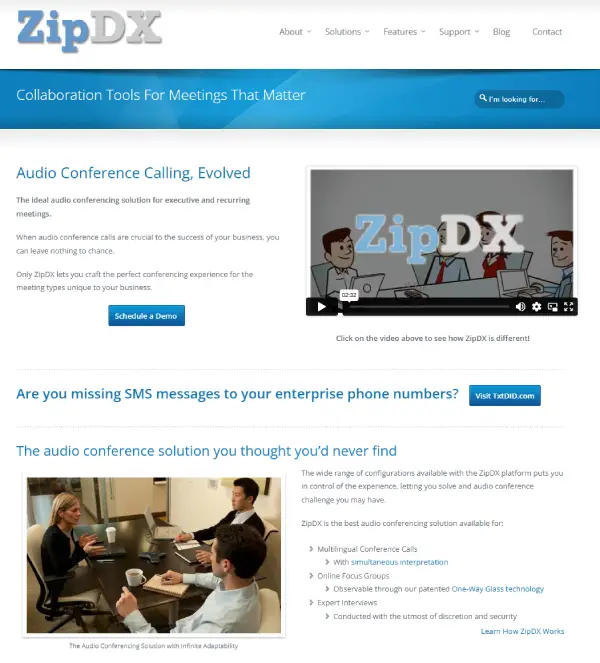
Pros
- Strong for audio-based meetings
- Special features for interpreter teams
- Stable platform with years of experience
Cons
- Dated interface compared to newer platforms
- Not optimized for video-heavy workflows
9. Wordfast
Wordfast is one of the world’s most widely used translation memory (TM) tools, helping translators and interpreters maintain consistency across large projects.
While it isn’t a live interpretation platform, it’s often used alongside events and content creation to prepare multilingual materials.
Wordfast offers affordability compared to competitors like SDL Trados, and it integrates easily with different file formats. For teams that need ongoing translation support in addition to live interpretation, Wordfast is a valuable complement to their toolkit.
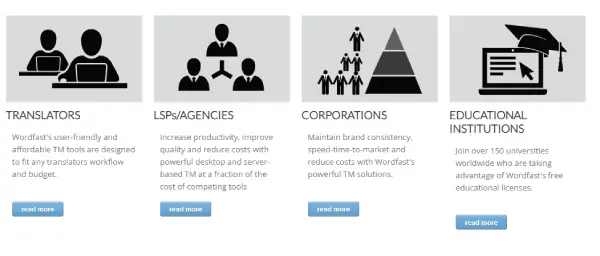
Pros
- Strong translation memory and glossary features
- Affordable compared to other CAT tools
- Works offline as well
Cons
- Not suitable for live events
- Learning curve for new users
10. SpeakUs
SpeakUs is a cloud-based simultaneous interpretation platform designed for live and hybrid events.
It removes the need for heavy equipment like traditional interpreter booths by streaming translations directly to attendees’ smartphones via an app.
Interpreters can also work remotely, cutting costs and setup time for event organizers. With features such as multilingual support, scalability for thousands of participants, and easy integration into conference workflows, SpeakUs is a practical solution for businesses and organizations looking for a modern, lightweight interpretation tool.
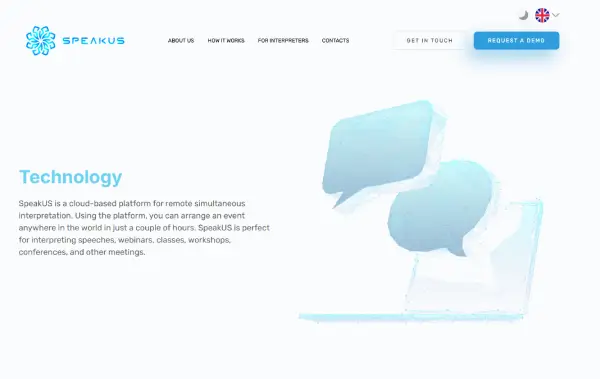
Pros
- User-friendly mobile app for attendees
- Good for corporate conferences
- Scales easily for hybrid meetings
Cons
- Requires professional interpreters
- Limited automation compared to AI-first solutions
Conclusion
Choosing the right alternative to Interprefy depends on your specific needs — whether it’s transcription accuracy, multilingual subtitling, or seamless voiceover features. Each tool we reviewed has its own strengths and limitations, so the best approach is to match your goals with the features that matter most to you.
If you’re looking for flexibility, scalability, and an all-in-one solution, Maestra is a strong first choice, while other platforms may be better suited for specialized requirements.
Whichever option you go with, investing in the right transcription and interpreting technology will save you time, reduce costs, and open the door to global communication.
FAQ
Are AI-based interpretation tools as accurate as human interpreters?
AI-based interpretation tools have made huge progress, especially for general conversations and multilingual meetings where speed matters. They offer affordability, instant availability, and support for dozens of languages at once. However, they may struggle with industry jargon, cultural nuances, or highly technical discussions. Human interpreters, on the other hand, excel in accuracy, tone, and context. The best solution often depends on your event:
AI tools are ideal for webinars, classrooms, and internal meetings where cost and speed are priorities.
Human interpreters are better suited for legal hearings, medical conferences, or diplomatic events where precision is critical.
Can these platforms handle hybrid events (in-person + online)?
Yes, many Interprefy alternatives are built specifically to support hybrid events, where some participants join onsite and others connect online. Platforms like KUDO, Interactio, and Clevercast allow interpreters to work remotely while delivering translations to both physical attendees (via headsets or apps) and virtual participants (via web or mobile). This flexibility ensures that everyone—regardless of location—can access the same high-quality interpretation.
Do I need special equipment to use these alternatives?
In most cases, no. Modern interpretation platforms are designed to work directly in your browser or through a mobile app. Attendees typically just need a laptop, tablet, or smartphone with headphones. Interpreters can also work remotely with nothing more than a computer, microphone, and stable internet connection. Unlike traditional setups that require booths, mixers, and headsets, cloud-based alternatives reduce costs and simplify logistics.
Which Interprefy alternative is best for small teams or startups?
For smaller teams or startups, affordability and ease of setup are usually the top priorities. AI-driven solutions like Wordly or Maestra stand out, as they provide real-time translation and captions without needing to book interpreters or rent hardware. These platforms often run on a simple pay-per-use or low-cost subscription model, making them accessible even for small budgets. If your events are casual meetings, internal trainings, or webinars, these lightweight tools can be the most practical choice.
What is the best option for large-scale international conferences?
For big events with thousands of participants and multiple language requirements, professional-grade platforms like KUDO or Interactio are often the best choice. These platforms are trusted by global organizations such as the UN and the European Parliament. They offer enterprise-level reliability, support for both human and remote interpreters, and scalability to handle thousands of simultaneous attendees. Extra features like polling, analytics, and integrations with Zoom or Microsoft Teams make them ideal for complex, large-scale setups.
How secure are these interpretation platforms?
Security is a top concern for businesses, governments, and healthcare organizations using interpretation services. Most leading platforms use end-to-end encryption, GDPR compliance, and enterprise-grade security protocols to ensure that sensitive information stays protected. If your event involves confidential discussions—such as board meetings, medical data, or government negotiations—make sure the provider clearly states their compliance standards and offers private server options.
What’s the difference between live interpretation and AI transcription/translation?
This is a common source of confusion:
Live interpretation: Spoken content is translated in real time into another language, either by a human interpreter or AI, so participants can listen instantly in their chosen language.
AI transcription/translation: The spoken content is first converted into text (transcription), and then translated into another language. This creates captions or written transcripts, but it’s not always simultaneous.
In short, interpretation is about real-time speech delivery, while transcription/translation focuses on text output. Some platforms (like Maestra) now combine both, giving you the flexibility to use audio, captions, or both depending on your audience.
